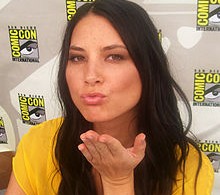Why is Olivia Munn is Pulling Her Hair Out?

What do you do when you feel stressed out?
For actress Olivia Munn, stress relief involves plucking out her eyelashes!
The 32-year-old Daily Show correspondent, who also currently stars in HBO’s Newsroom and the film Magic Mike, recently told the New York Daily News:
I don’t bite my nails, but I rip out my eyelashes. It doesn’t hurt, but it’s really annoying. Every time I run out of the house, I have to stop and pick up a whole set of fake eyelashes.
Munn says that she suffers from social anxiety, stemming from her youth as an Air Force kid, whose family had to move frequently.
I don’t think anyone would describe me as weak, but I don’t want people to be mean to me. … I moved around a lot when I was younger and no one was nice to the new kid. So there is always this feeling that someone will make fun of me.
What is Trichotillomania, beside being a funny sounding word?
Trichotillomania is hair loss from repeated urges to pull or twist the hair until it breaks off. Patients are unable to stop this behavior, even as their hair becomes thinner.
It is a type of impulsive control disorder whose causes are not clearly understood.
It may affect as much as 4% of the population. Women are four times more likely to be affected than men.
Symptoms usually begin before age 17. The hair may come out in round patches or across the scalp. The effect is an uneven appearance. The scalp is the most common pulling site, followed by the eyebrows, eyelashes, face, arms, and legs.
Individuals with trichotillomania exhibit hair of differing lengths; some are broken hairs with blunt ends, some new growth with tapered ends, some broken mid-shaft, or some uneven stubble.
Children can also have trichotillomania. Their symptoms include:
- An uneven appearance to the hair
- Bare patches or all around (diffuse) loss of hair
- Bowel blockage (obstruction) if people eat the hair they pull out
- Constant tugging, pulling, or twisting of hair
- Denying the hair pulling
- Hair regrowth that feels like stubble in the bare spots
- Increasing sense of tension before the hair pulling
- Other self-injury behaviors
- Sense of relief, pleasure, or gratification after the hair pulling
Most people with this disorder also have problems with:
- Feeling sad or depressed
- Anxiety
- Poor self image
Experts don’t agree on the use of medication for treatment. However, naltrexone and selective serotonin reuptake inhibitors (SSRIs) have been shown effective in reducing some symptoms. Behavioral therapy and habit reversal may also be effective.
One method is called Habit Reversal Training (HRT). HRT can be used alone or as an adjunct to medication as a way to treat trichotillomania. With HRT, doctors train the individual to learn to recognize their impulse to pull and also teach them to redirect this impulse.
Trichotillomania that begins in younger children (less than 6 years old) may go away without treatment. For most people, the hair pulling ends within 12 months.
For others, trichotillomania is a lifelong disorder. However, treatment often improves the hair pulling and the feelings of depression, anxiety, or poor self image.
People can have complications when they eat the pulled-out hair (trichophagia). This can cause a blockage in the intestines or lead to poor nutrition.

























0 comments